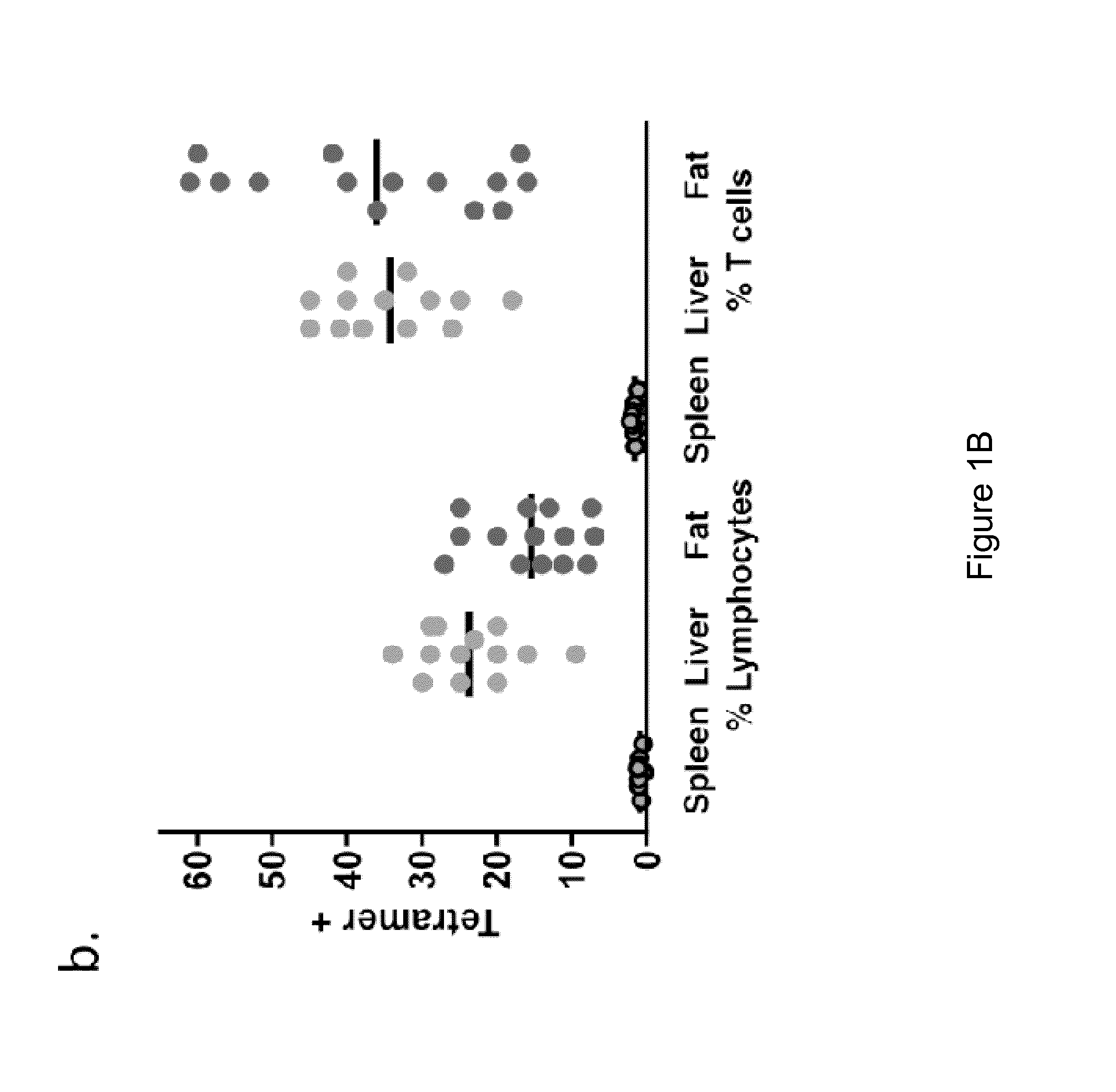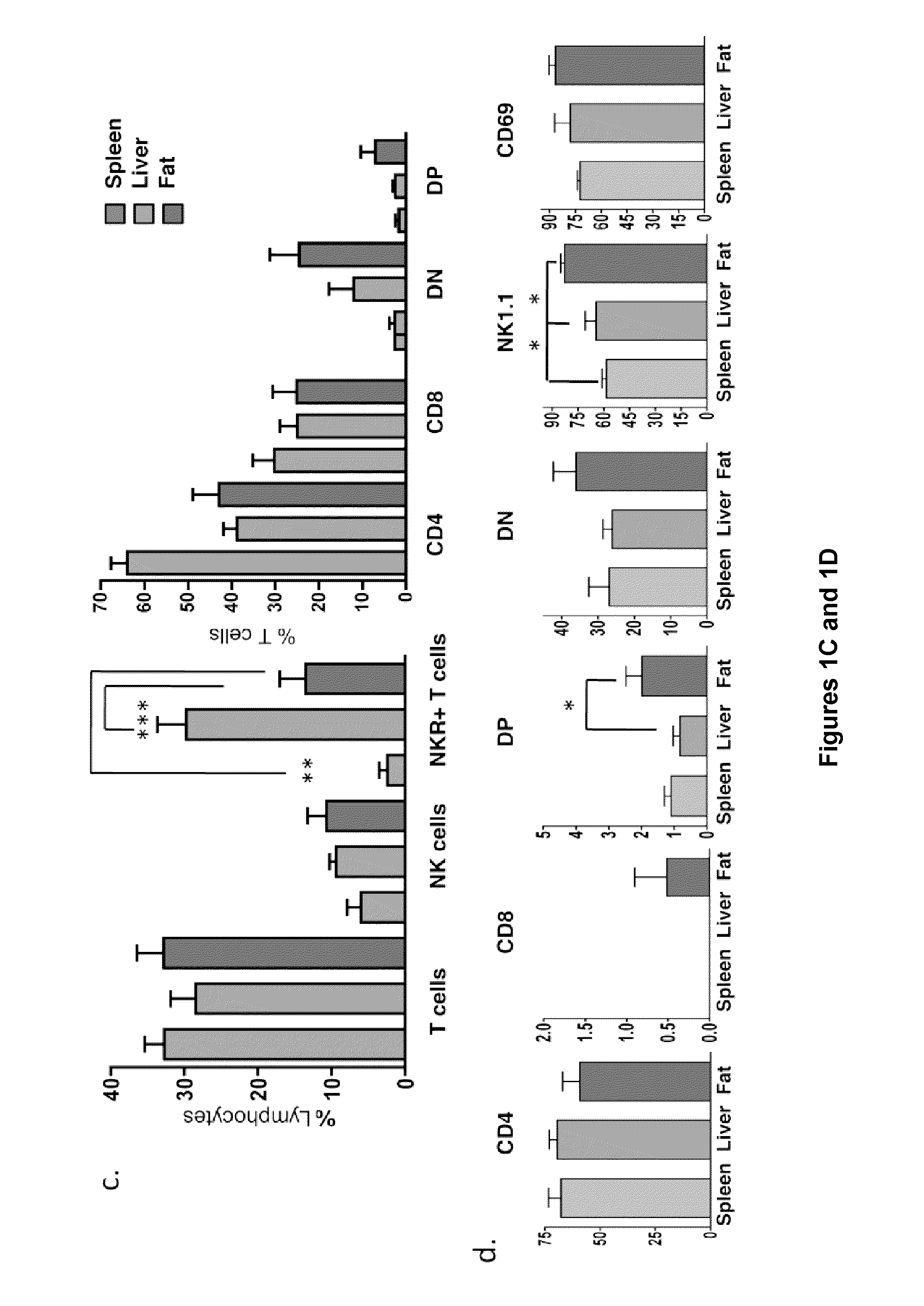Methods and compositions for treatment of metabolic disorders
- Summary
- Abstract
- Description
- Claims
- Application Information
AI Technical Summary
Benefits of technology
Problems solved by technology
Method used
Image
Examples
example 1
Adipose Tissue is Enriched for iNKT
[0072]Adipose tissue consists of adipocytes and heterogeneous cell populations in the stromovascular fraction (SVF), including vascular endothelium, mesenchymal stem cells, macrophages and unique lymphocytes. iNKT have not previously been described in murine adipose. ˜8% of adipose SVF were lymphocytes. The majority of these were T cells (60-80%). Of total lymphocytes in SVF, ˜15% were iNKT, compared to 20% in liver and 1% in spleen (FIGS. 1A and 1B). Of total T cells in SVF, up to 60% were iNKT (mean 40%), compared to 2% of splenic T cells and 35% of hepatic T cells (FIGS. 1A and 1B), thus illustrating enrichment of iNKT among adipose T cells. Previous studies showed that the highest iNKT / T cell ratio was seen in murine liver (Ebert et al., J Immunol. 162:6410-9, 1999; Bendelac et al., Annu Rev Immunol. 25:297-336, 2007). In our current studies, we calculated absolute numbers of T cells and iNKT (Tables 1A and 1B). Each fat depot contains ˜8.4×106...
example 2
iNKT Cells are Depleted in Fat and Liver During the Development of Obesity
[0075]iNKT cells are reduced in the circulation of obese patients compared to lean healthy age-matched controls (FIG. 2). A cross-sectional analysis of obese patients found that obese patients who had lost weight over 18 months following bariatric surgery, had significantly increased circulating iNKT cells levels compared to patients pre-bariatric surgery, although iNKT cells were still reduced compared to lean controls (FIG. 2). We then followed a small group of patients (n=7) longitudinally pre- and post-bariatric surgery, whose BMI decreased from Grade III obesity (mean BMI>50) to Grade II obesity (mean BMI 35-40) over 18 months post-surgery (FIG. 2). Peripheral iNKT cell levels increased in each patient following weight loss (FIG. 2).
example 3
Cytokine Production by Adipose Tissue iNKT
[0076]Following injection of αGC, adipose iNKT did not produce IFNγ in vivo, unlike iNKT in liver or spleen (FIG. 3A, p=0.01). Adipose-derived iNKT also produced slightly less IL-4. However, adipose iNKT produced significantly more IL-10 (FIG. 3A, p90% purity) and stimulated in vitro with αGC. Adipose-derived iNKT produced significantly less IFNγ than splenic or hepatic iNKT in vitro. IL-4 production did not differ per iNKT origin. Further confirming the in vivo experiments, adipose iNKT produced significantly more IL-10 per cell than iNKT from liver or spleen (FIG. 3B).
PUM
| Property | Measurement | Unit |
|---|---|---|
| Therapeutic | aaaaa | aaaaa |
| Pharmaceutically acceptable | aaaaa | aaaaa |
Abstract
Description
Claims
Application Information
 Login to View More
Login to View More - R&D
- Intellectual Property
- Life Sciences
- Materials
- Tech Scout
- Unparalleled Data Quality
- Higher Quality Content
- 60% Fewer Hallucinations
Browse by: Latest US Patents, China's latest patents, Technical Efficacy Thesaurus, Application Domain, Technology Topic, Popular Technical Reports.
© 2025 PatSnap. All rights reserved.Legal|Privacy policy|Modern Slavery Act Transparency Statement|Sitemap|About US| Contact US: help@patsnap.com



